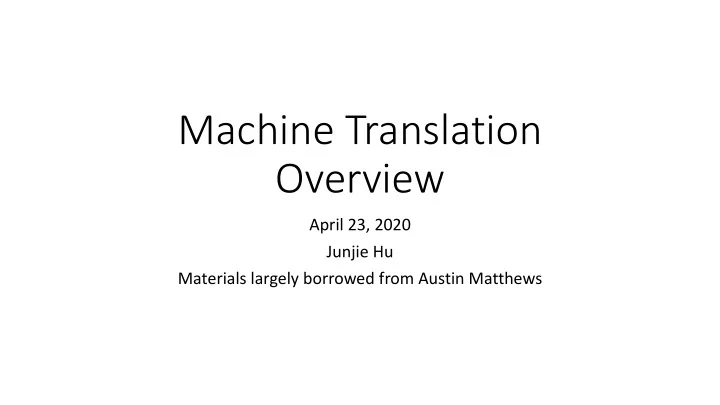

“Deep”
“Deep”
“Deep” Note:
“Recurrent”
Design Decisions • How to represent inputs and outputs? • Neural architecture? • How many layers? (Requires non-linearities to improve capacity!) • How many neurons? • Recurrent or not? • What kind of non-linearities?
Representing Language • “One-hot” vectors • Each position in a vector corresponds to a word type Aardvark Aabalone Abandon Abash Dog … … dog = <0 0 0 0 0 0 0 0 0 0 0 0 0 0 0 0 0 1 0 0 0 0 0 0 0 0 0 0 0 0 0 0 0> • Distributed representations • Vectors encode “features” of input words (character n-grams, morphological features, etc.) dog = <0.79995, 0.67263, 0.73924, 0.77496, 0.09286, 0.802798, 0.35508, 0.44789>
Training Neural Networks • Neural networks are supervised models – you need a set of inputs paired with outputs • Algorithm • Run until bored: • Give input to the network, see what it predicts • Compute loss(y, y*) • Use chain rule (aka “back propagation”) to compute gradient with respect to parameters • Update parameters (SGD, Adam, LBFGS, etc.)
Neural Language Models softmax tanh x=x Bengio et al. (2013)
Bengio et al. (2003)
Neural Features for Translation • Turn Bengio et al. (2003) into a translation model • Condtional model, generate the next English word conditioned on • The previous n English words you generated • The aligned source word and its m neighbors Devlin et al. (2014)
softmax tanh Devlin et al. (2014) x=x
Neural Features for Translation Devlin et al. (2014)
Notation Simplification
RNNs Revisited
Fully Neural Translation • Fully end-to-end RNN-based translation model • Encode the source sentence using one RNN • Generate the target sentence one word at a time using another RNN je suis étudiant </s> Encoder Decoder I am a student </s> je suis étudiant Sutskever et al. (2014)
Attentional Model • The encoder-decoder model struggles with long sentences • An RNN is trying to compress an arbitrarily long sentence into a finite- length worth vector • What if we only look at one (or a few) source words when we generate each output word? Bahdanau et al. (2014)
The Intuition 。 うち の ⼤きな ⿊い ⽝ が 可哀想な 郵便屋 に 噛み ついた Our large black dog bit the poor mailman . 83 Bahdanau et al. (2014)
The Attention Model Encoder Decoder I am a student </s> Bahdanau et al. (2014)
The Attention Model Attention Model Encoder Decoder I am a student </s> Bahdanau et al. (2014)
The Attention Model softmax Attention Model Encoder Decoder I am a student </s> Bahdanau et al. (2014)
The Attention Model Context Vector Attention Model Encoder Decoder I am a student </s> Bahdanau et al. (2014)
The Attention Model Context Vector Attention Model je Encoder Decoder I am a student </s> Bahdanau et al. (2014)
The Attention Model Context Vector Attention Model je Encoder Decoder I am a student </s> je Bahdanau et al. (2014)
The Attention Model Attention Model je Encoder Decoder I am a student </s> je Bahdanau et al. (2014)
The Attention Model Context Vector Attention Model je suis Encoder Decoder I am a student </s> je Bahdanau et al. (2014)
The Attention Model Context Vector Attention Model je suis Encoder Decoder I am a student </s> je suis Bahdanau et al. (2014)
The Attention Model Context Vector Attention Model je suis étudiant Encoder Decoder I am a student </s> je suis étudiant Bahdanau et al. (2014)
The Attention Model Context Vector Attention Model je suis étudiant </s> Encoder Decoder I am a student </s> je suis étudiant Bahdanau et al. (2014)
Convolutional Encoder-Decoder Gehring et. al 2017 • CNN: • encodes words within a fixed size window • Parallel computation • Shortest path to cover a wider range of words • RNN: • sequentially encode a sentence from left to right • Hard to parallelize
The Transformer • Idea: Instead of using an RNN to encode the source sentence and the partial target sentence, use self-attention! Self Attention Encoder Standard RNN Encoder word-in-context vector raw word vector I am a student </s> I am a student </s> Vaswani et al. (2017)
The Transformer Context Vector Attention Model je suis étudiant </s> Encoder Decoder je suis étudiant I am a student </s> Vaswani et al. (2017)
Transformer • Traditional attention: • Query: decoder hidden state • Key and Value: encoder hidden state • Attend to source words based on the current decoder state • Self-attention: • Query, Key, Value are the same • Attend to surrounding source words based on the current source word • Attend to preceeding target words based on the current target word Vaswani et al. (2017)
Visualization of Attention Weight • Self-attention weight can detect long-term dependency within a sentence, e.g., make … more difficult
The Transformer • Computation is easily parallelizable • Shorter path from each target word to each source word à stronger gradient signals • Empirically stronger translation performance • Empirically trains substantially faster than more serial models
Recommend
More recommend